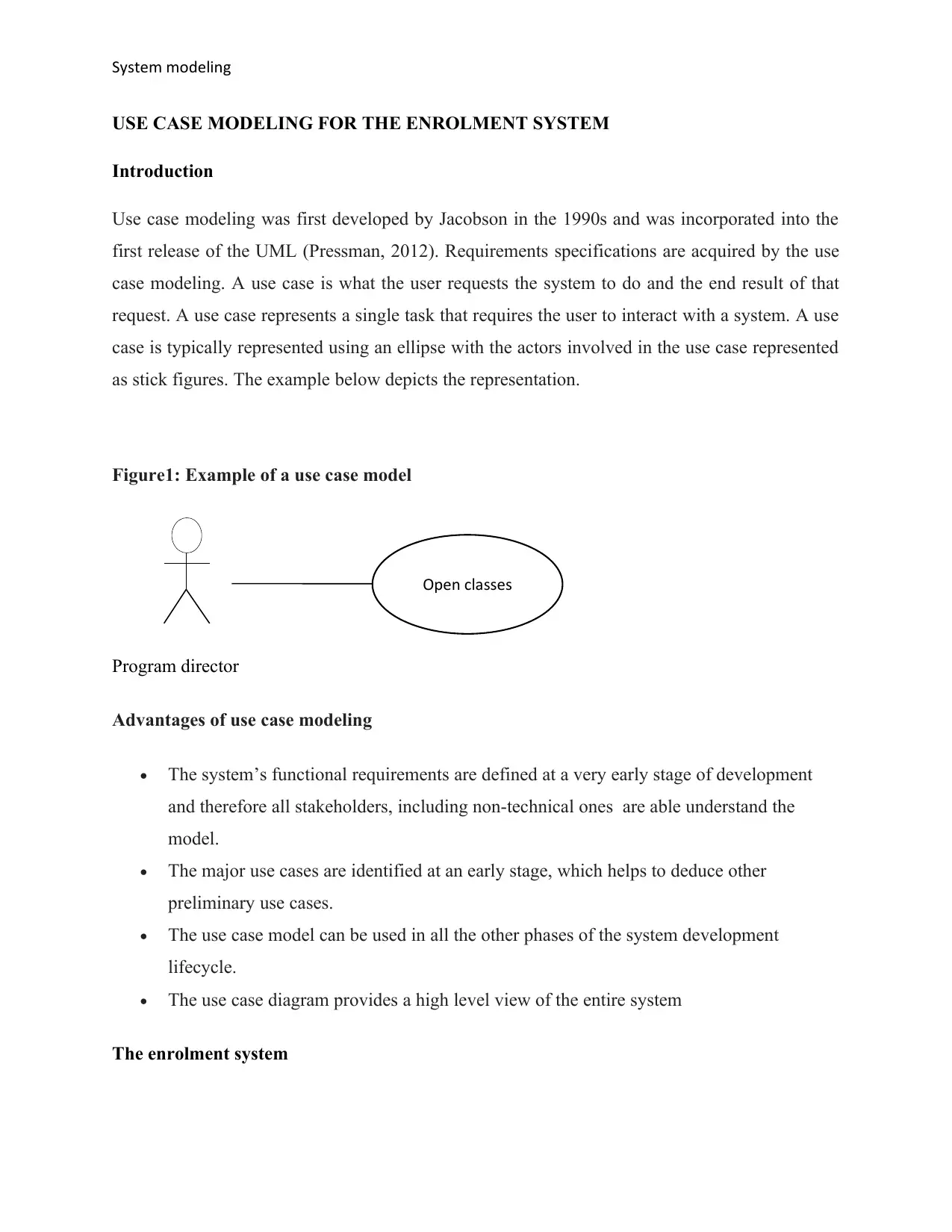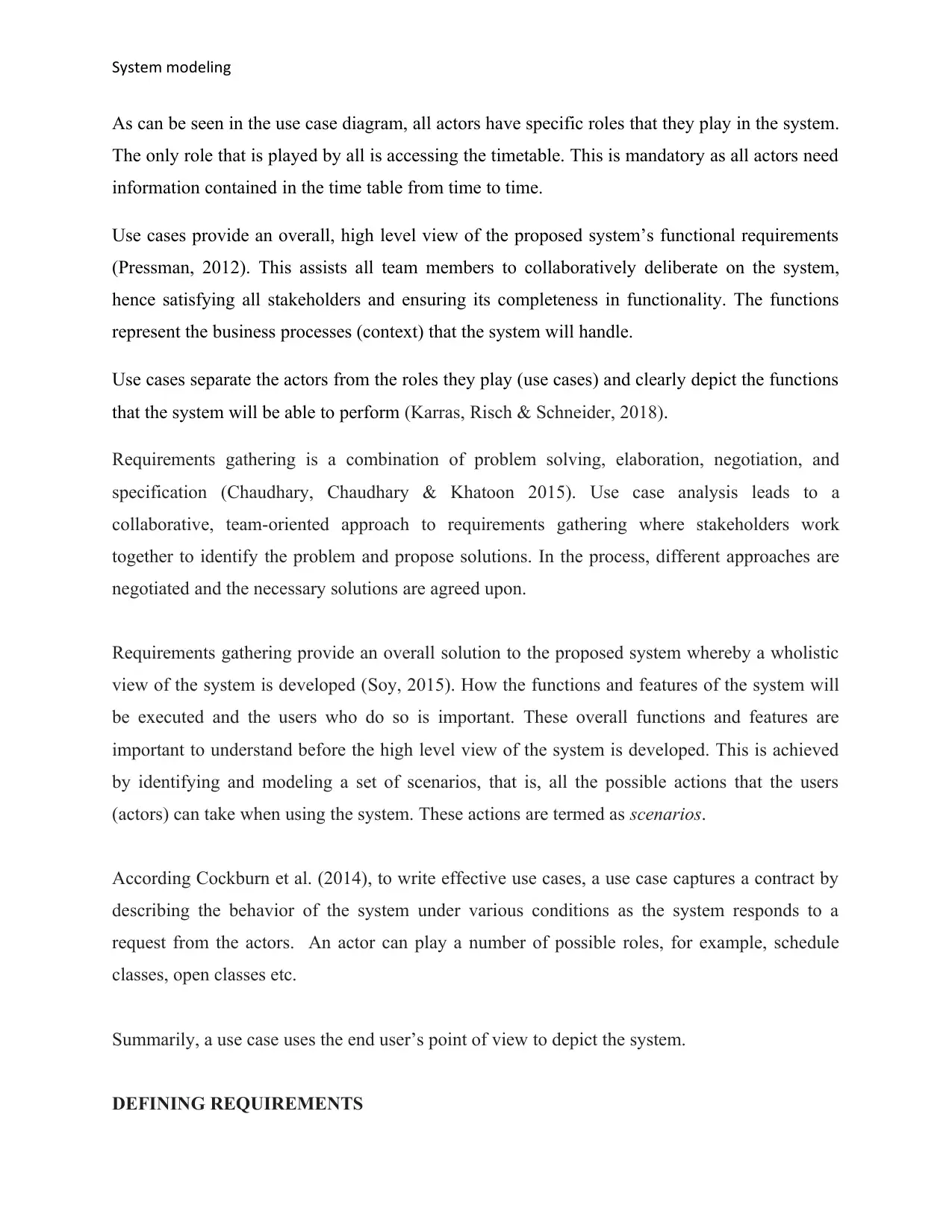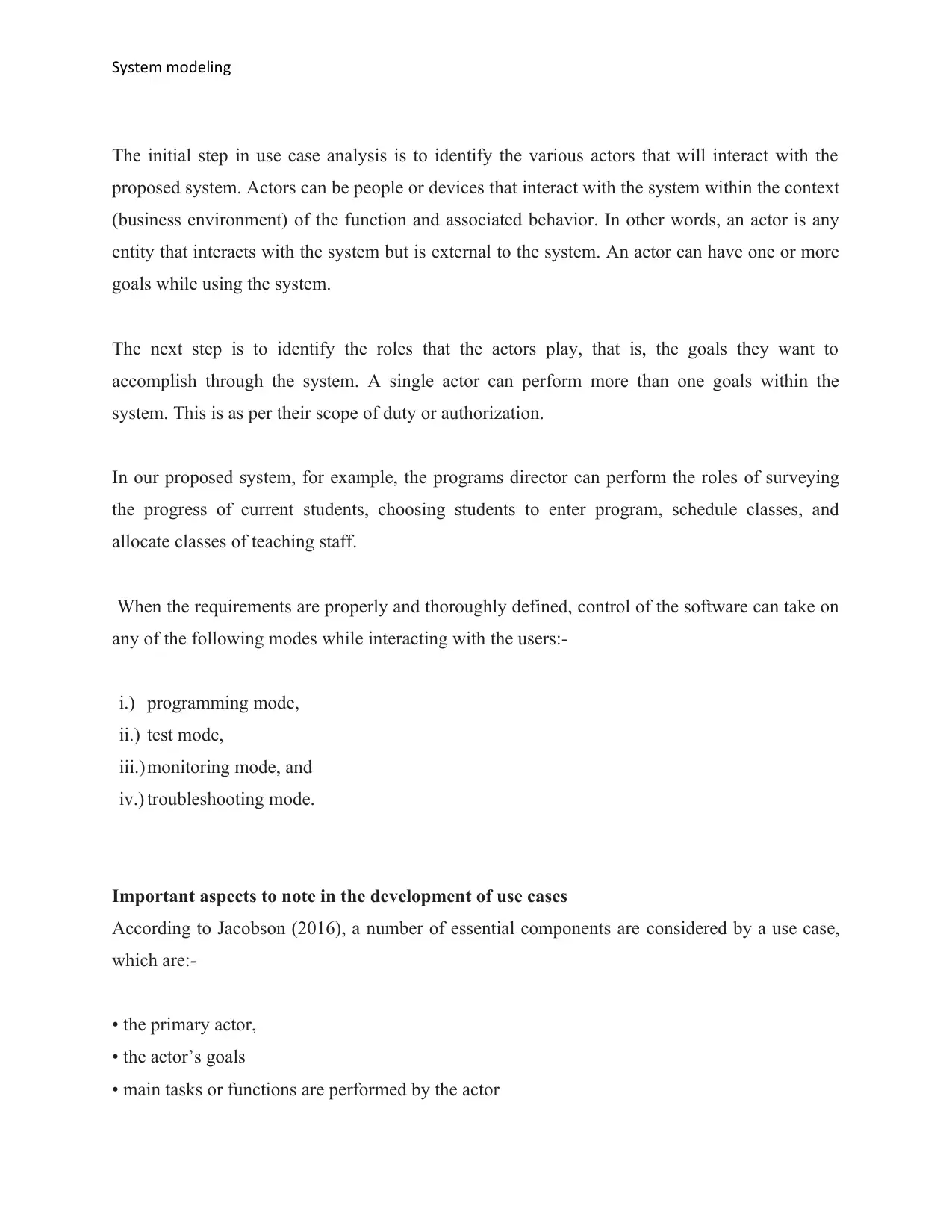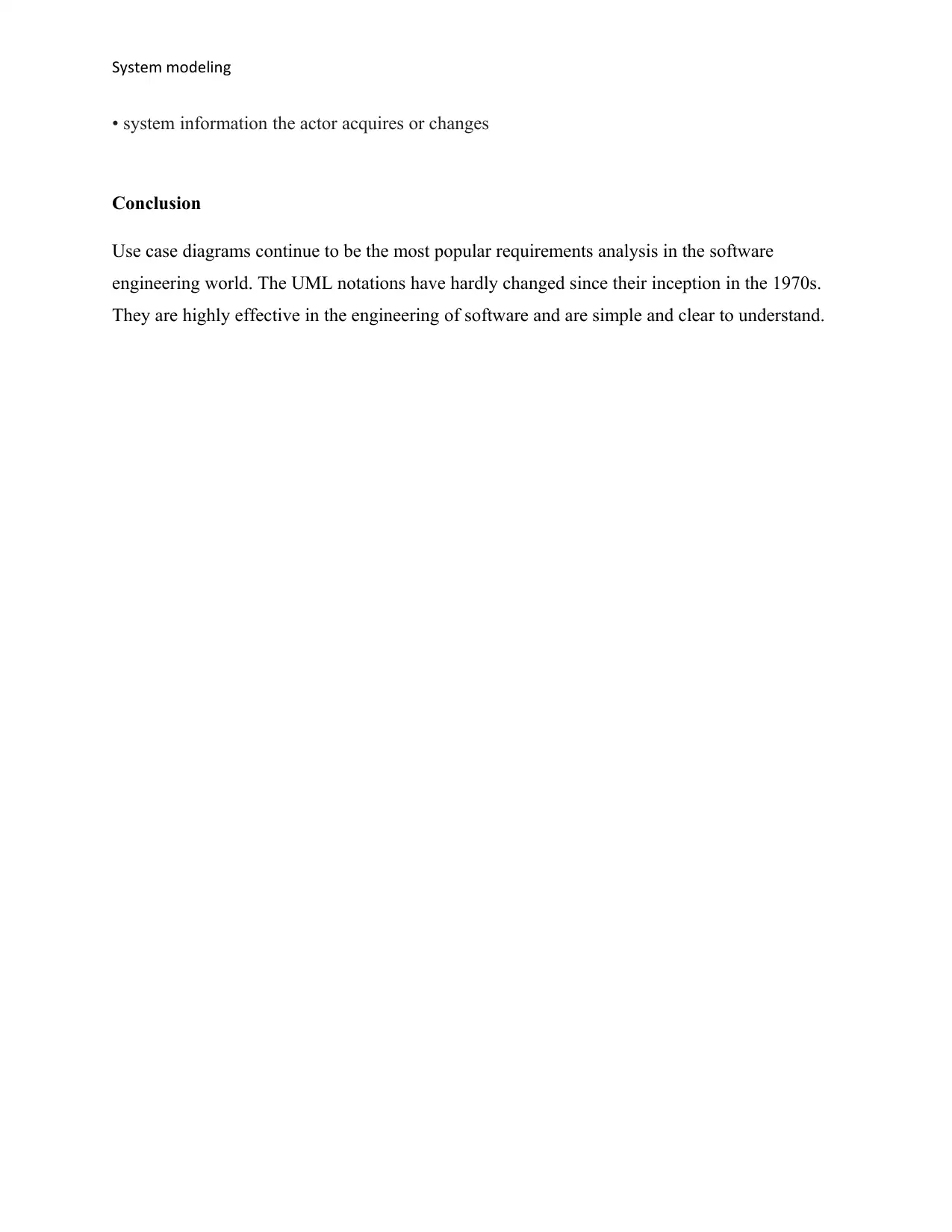MIS501 - Use Case Modeling: Designing an Enrollment System
VerifiedAdded on 2023/06/04
|7
|1360
|313
Report
AI Summary
This report provides a detailed exploration of use case modeling for an enrollment system, focusing on the actors involved—program director, students, timetabling manager, and teaching staff—and their respective roles within the system. It outlines the advantages of use case modeling, such as defining functional requirements early and providing a high-level system view. The report includes a use case diagram illustrating the interactions between actors and the system, emphasizing the importance of requirements gathering through collaborative, team-oriented approaches. It also discusses essential components of use cases, including primary actors, their goals, and system information. The conclusion highlights the continued popularity and effectiveness of use case diagrams in software engineering for requirements analysis.

System modeling
USE CASE MODELING FOR THE ENROLMENT SYSTEM
Introduction
Use case modeling was first developed by Jacobson in the 1990s and was incorporated into the
first release of the UML (Pressman, 2012). Requirements specifications are acquired by the use
case modeling. A use case is what the user requests the system to do and the end result of that
request. A use case represents a single task that requires the user to interact with a system. A use
case is typically represented using an ellipse with the actors involved in the use case represented
as stick figures. The example below depicts the representation.
Figure1: Example of a use case model
Program director
Advantages of use case modeling
The system’s functional requirements are defined at a very early stage of development
and therefore all stakeholders, including non-technical ones are able understand the
model.
The major use cases are identified at an early stage, which helps to deduce other
preliminary use cases.
The use case model can be used in all the other phases of the system development
lifecycle.
The use case diagram provides a high level view of the entire system
The enrolment system
Open classes
USE CASE MODELING FOR THE ENROLMENT SYSTEM
Introduction
Use case modeling was first developed by Jacobson in the 1990s and was incorporated into the
first release of the UML (Pressman, 2012). Requirements specifications are acquired by the use
case modeling. A use case is what the user requests the system to do and the end result of that
request. A use case represents a single task that requires the user to interact with a system. A use
case is typically represented using an ellipse with the actors involved in the use case represented
as stick figures. The example below depicts the representation.
Figure1: Example of a use case model
Program director
Advantages of use case modeling
The system’s functional requirements are defined at a very early stage of development
and therefore all stakeholders, including non-technical ones are able understand the
model.
The major use cases are identified at an early stage, which helps to deduce other
preliminary use cases.
The use case model can be used in all the other phases of the system development
lifecycle.
The use case diagram provides a high level view of the entire system
The enrolment system
Open classes
Paraphrase This Document
Need a fresh take? Get an instant paraphrase of this document with our AI Paraphraser

System modeling
The proposed enrolment system comprises of four actors who include the program director, the
students, the timetabling manager and the teaching staff. Each has no less than two roles to play
in the system. They are expounded in the section below.
Actors and their roles
i.) Program director
Survey progress of current students
Choose students to enter program
Schedule classes
Allocate classes to teaching staff
Open classes
Access timetable
ii.) Student
Enroll into class
Access timetable
iii.)Timetabling manager
Allocate classrooms to classes
Avail classes
Access timetable
iv.) Teaching staff
Access timetable
The proposed enrolment system comprises of four actors who include the program director, the
students, the timetabling manager and the teaching staff. Each has no less than two roles to play
in the system. They are expounded in the section below.
Actors and their roles
i.) Program director
Survey progress of current students
Choose students to enter program
Schedule classes
Allocate classes to teaching staff
Open classes
Access timetable
ii.) Student
Enroll into class
Access timetable
iii.)Timetabling manager
Allocate classrooms to classes
Avail classes
Access timetable
iv.) Teaching staff
Access timetable

System modeling
Use case model
Use case model
⊘ This is a preview!⊘
Do you want full access?
Subscribe today to unlock all pages.

Trusted by 1+ million students worldwide

System modeling
Paraphrase This Document
Need a fresh take? Get an instant paraphrase of this document with our AI Paraphraser

System modeling
As can be seen in the use case diagram, all actors have specific roles that they play in the system.
The only role that is played by all is accessing the timetable. This is mandatory as all actors need
information contained in the time table from time to time.
Use cases provide an overall, high level view of the proposed system’s functional requirements
(Pressman, 2012). This assists all team members to collaboratively deliberate on the system,
hence satisfying all stakeholders and ensuring its completeness in functionality. The functions
represent the business processes (context) that the system will handle.
Use cases separate the actors from the roles they play (use cases) and clearly depict the functions
that the system will be able to perform (Karras, Risch & Schneider, 2018).
Requirements gathering is a combination of problem solving, elaboration, negotiation, and
specification (Chaudhary, Chaudhary & Khatoon 2015). Use case analysis leads to a
collaborative, team-oriented approach to requirements gathering where stakeholders work
together to identify the problem and propose solutions. In the process, different approaches are
negotiated and the necessary solutions are agreed upon.
Requirements gathering provide an overall solution to the proposed system whereby a wholistic
view of the system is developed (Soy, 2015). How the functions and features of the system will
be executed and the users who do so is important. These overall functions and features are
important to understand before the high level view of the system is developed. This is achieved
by identifying and modeling a set of scenarios, that is, all the possible actions that the users
(actors) can take when using the system. These actions are termed as scenarios.
According Cockburn et al. (2014), to write effective use cases, a use case captures a contract by
describing the behavior of the system under various conditions as the system responds to a
request from the actors. An actor can play a number of possible roles, for example, schedule
classes, open classes etc.
Summarily, a use case uses the end user’s point of view to depict the system.
DEFINING REQUIREMENTS
As can be seen in the use case diagram, all actors have specific roles that they play in the system.
The only role that is played by all is accessing the timetable. This is mandatory as all actors need
information contained in the time table from time to time.
Use cases provide an overall, high level view of the proposed system’s functional requirements
(Pressman, 2012). This assists all team members to collaboratively deliberate on the system,
hence satisfying all stakeholders and ensuring its completeness in functionality. The functions
represent the business processes (context) that the system will handle.
Use cases separate the actors from the roles they play (use cases) and clearly depict the functions
that the system will be able to perform (Karras, Risch & Schneider, 2018).
Requirements gathering is a combination of problem solving, elaboration, negotiation, and
specification (Chaudhary, Chaudhary & Khatoon 2015). Use case analysis leads to a
collaborative, team-oriented approach to requirements gathering where stakeholders work
together to identify the problem and propose solutions. In the process, different approaches are
negotiated and the necessary solutions are agreed upon.
Requirements gathering provide an overall solution to the proposed system whereby a wholistic
view of the system is developed (Soy, 2015). How the functions and features of the system will
be executed and the users who do so is important. These overall functions and features are
important to understand before the high level view of the system is developed. This is achieved
by identifying and modeling a set of scenarios, that is, all the possible actions that the users
(actors) can take when using the system. These actions are termed as scenarios.
According Cockburn et al. (2014), to write effective use cases, a use case captures a contract by
describing the behavior of the system under various conditions as the system responds to a
request from the actors. An actor can play a number of possible roles, for example, schedule
classes, open classes etc.
Summarily, a use case uses the end user’s point of view to depict the system.
DEFINING REQUIREMENTS

System modeling
The initial step in use case analysis is to identify the various actors that will interact with the
proposed system. Actors can be people or devices that interact with the system within the context
(business environment) of the function and associated behavior. In other words, an actor is any
entity that interacts with the system but is external to the system. An actor can have one or more
goals while using the system.
The next step is to identify the roles that the actors play, that is, the goals they want to
accomplish through the system. A single actor can perform more than one goals within the
system. This is as per their scope of duty or authorization.
In our proposed system, for example, the programs director can perform the roles of surveying
the progress of current students, choosing students to enter program, schedule classes, and
allocate classes of teaching staff.
When the requirements are properly and thoroughly defined, control of the software can take on
any of the following modes while interacting with the users:-
i.) programming mode,
ii.) test mode,
iii.)monitoring mode, and
iv.) troubleshooting mode.
Important aspects to note in the development of use cases
According to Jacobson (2016), a number of essential components are considered by a use case,
which are:-
• the primary actor,
• the actor’s goals
• main tasks or functions are performed by the actor
The initial step in use case analysis is to identify the various actors that will interact with the
proposed system. Actors can be people or devices that interact with the system within the context
(business environment) of the function and associated behavior. In other words, an actor is any
entity that interacts with the system but is external to the system. An actor can have one or more
goals while using the system.
The next step is to identify the roles that the actors play, that is, the goals they want to
accomplish through the system. A single actor can perform more than one goals within the
system. This is as per their scope of duty or authorization.
In our proposed system, for example, the programs director can perform the roles of surveying
the progress of current students, choosing students to enter program, schedule classes, and
allocate classes of teaching staff.
When the requirements are properly and thoroughly defined, control of the software can take on
any of the following modes while interacting with the users:-
i.) programming mode,
ii.) test mode,
iii.)monitoring mode, and
iv.) troubleshooting mode.
Important aspects to note in the development of use cases
According to Jacobson (2016), a number of essential components are considered by a use case,
which are:-
• the primary actor,
• the actor’s goals
• main tasks or functions are performed by the actor
⊘ This is a preview!⊘
Do you want full access?
Subscribe today to unlock all pages.

Trusted by 1+ million students worldwide

System modeling
• system information the actor acquires or changes
Conclusion
Use case diagrams continue to be the most popular requirements analysis in the software
engineering world. The UML notations have hardly changed since their inception in the 1970s.
They are highly effective in the engineering of software and are simple and clear to understand.
• system information the actor acquires or changes
Conclusion
Use case diagrams continue to be the most popular requirements analysis in the software
engineering world. The UML notations have hardly changed since their inception in the 1970s.
They are highly effective in the engineering of software and are simple and clear to understand.
1 out of 7
Related Documents
Your All-in-One AI-Powered Toolkit for Academic Success.
+13062052269
info@desklib.com
Available 24*7 on WhatsApp / Email
![[object Object]](/_next/static/media/star-bottom.7253800d.svg)
Unlock your academic potential
Copyright © 2020–2025 A2Z Services. All Rights Reserved. Developed and managed by ZUCOL.





